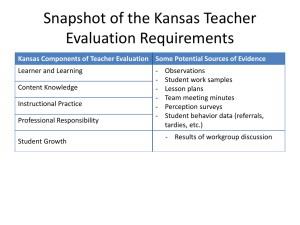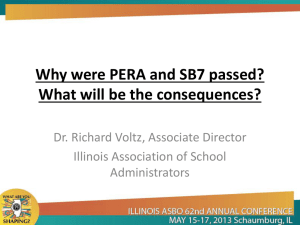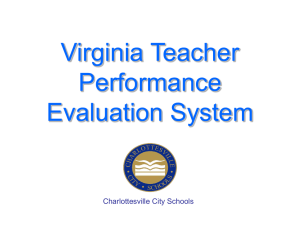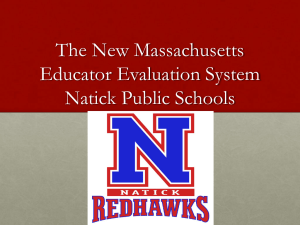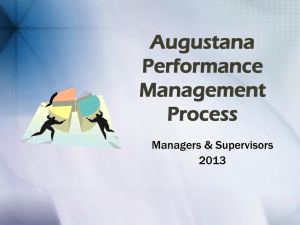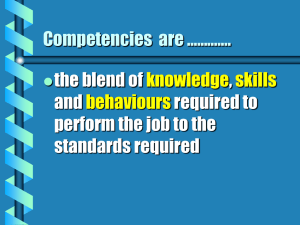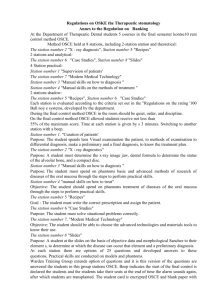Professional Appraisal System Presentation
advertisement
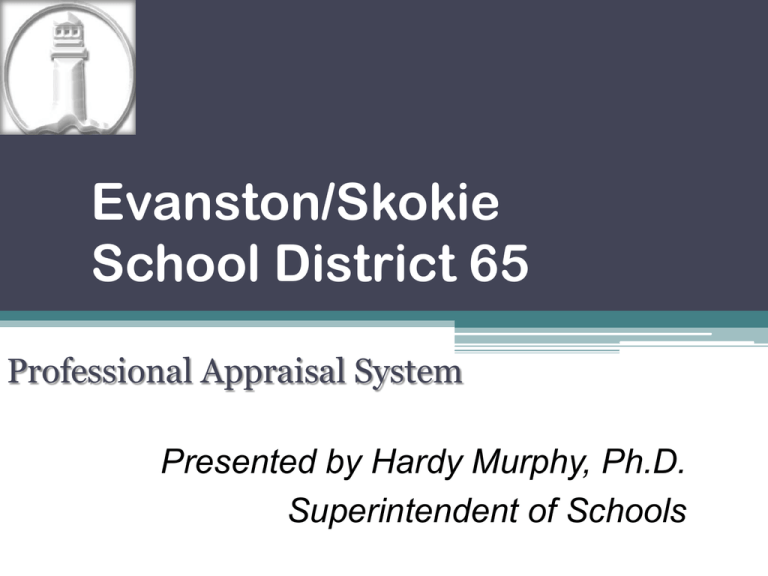
Evanston/Skokie School District 65 Professional Appraisal System Presented by Hardy Murphy, Ph.D. Superintendent of Schools Two topics at the forefront of debate in public education reform have been (1) how to accurately measure student growth (outcomes) and (2) how to effectively measure the teacher’s job performance (inputs). The goal is to have all students achieving a very high levels; to overcome the gaps in education between those who traditionally excel and those who traditionally struggle. A successful approach looks at student performance (outcomes) as well as teacher professionalism (inputs). It is founded upon the understanding that all students should grow at least a year given a year’s instruction, and excellent teaching should result in more students achieving at higher levels. The characteristics or components of an effective evaluation system must include (1) ongoing databased dialogue between teachers and evaluators about the teaching and learning process, (2) establishing goals related to inputs (Danielson) common to the profession, (3) identifying agreed upon measures of student growth that can validate teaching and learning, and 4) redefining criteria for student progress so they are anchored in conceptual expressions to address growth for individual and groups of students. Concepts such as more, most, trend, improvement, grade level and growth over time are very important as they facilitate the definition of student performance into metrics that can be used to effectively measure student achievement in the evaluation system. More students doing better in each of the classrooms in our schools is what we all desire. Creating a culture where this can occur over time builds momentum in an instructional program that allows the school to move forward. The Evanston/Skokie District 65 performance appraisal system, developed through a collaborative, problem solving process that included teachers, administrators and other educational professionals addresses the concerns outlined above. And, I believe it can go a long way toward addressing the concerns ever present in the debate over the relationship between student performance and teacher evaluations. Hardy Murphy, Ph.D., Superintendent of Schools Evaluation Side Letter During the 2008 teacher contract negotiations, the District Educators’ Council (DEC) and Board of Education agreed to revise the professional agreement and the professional appraisal system to provide the ratings of Excellent, Satisfactory and Unsatisfactory. A Joint Teacher Evaluation Committee, assisted by mutually agreed upon facilitators, came to consensus and provided recommendations to implement a new professional appraisal system for the 2009-10 school year. 4 The Challenge Develop a system built with agreed-upon student performance criteria for determining teacher performance ratings, and Find a solution that incorporates agreedupon measures of student growth. The Solution A performance model defined around broad conceptual indicators of student growth that encompass measures within acceptable parameters, e.g., more, the same, less/fewer, trend, and most. 5 Student Growth Expected growth is a year’s increase in achievement for one year in school. (One year of academic growth for one year of instruction should be a minimum expectation.) Improved growth is when student(s) exceed a year’s growth for a year of attendance. Grade level is defined as functioning at the 50th percentile. Improved student achievement is essential to close the achievement gap. 6 Student Growth Measures Student growth is assessed by using: ▫ Grade level expectations ▫ Content area expectations ▫ A mix of measures (e.g. more than one assessment result should be used when reviewing documentation relative to student growth; may vary from grade to grade and by subject) 7 Levels of Student Performance and Trend Student performance is either ▫ At and above grade level or ▫ Below grade level An Upward Trend is achieved when most students have grown a year, and at least one student grows more than a year A Downward Trend is when most students have grown less than a year 8 Teacher rated Excellent for student growth More students at and above grade level at the end of the year than at the beginning. However, in determining the performance rating, the principal and teacher shall discuss the growth trend of the class to ensure that a fair and accurate summative rating is given to the teacher. 9 Teacher Rated Satisfactory for student growth The same number of students at and above grade level at the end of the year as at the beginning. However, in determining the performance rating, the principal and teacher shall discuss the growth trend of the class to ensure that a fair and accurate summative rating is given to the teacher. 10 Teacher rated Unsatisfactory for Student Growth Fewer students at and above grade level at the end of the year as at the beginning of the year. However, in determining the performance rating, the principal and teacher shall discuss the growth trend of the class to ensure that a fair and accurate summative rating is given to the teacher. 11 Shared Responsibility When more than one teacher is significantly engaged in a student’s education (general education, special education, reading/learning specialists and/or others), they will share responsibility for the student’s growth. These teachers will collaboratively develop challenging standards-based goals and jointly monitor student progress. In the case of a student with an IEP, the IEP can meet this requirement. Extenuating Circumstances A teacher is responsible for the growth of all students. However, extenuating circumstances that impact the achievement level of some students may be considered. Extenuating factors include, but are not limited to: •behavioral •emotional •health concerns •family issues •attendance •enrollment date The impact extenuating factors may have on student growth should be identified by the teacher and addressed during ongoing conversations throughout the year between the teacher and evaluator, as well as at the summative conference. 12 Summative Ratings A summative conference is held at the end of the year. Teacher and evaluator discuss the teacher’s performance related to: •Danielson Framework (the teaching/instructional process) •Student Growth (the teaching/instructional outcomes) Teacher and evaluator review trend* data, extenuating circumstances and other appropriate documentation. *Upward or downward trend in student achievement can change a growth rating even though there is no change in the number of students at and above grade level or below grade level when comparing end of year to beginning of the year. Arriving at the Summative Rating Danielson Growth Summative Excellent Excellent Excellent Excellent Satisfactory Excellent or Satisfactory* Excellent Unsatisfactory Satisfactory or Unsatisfactory* Satisfactory Excellent Excellent or Satisfactory* Satisfactory Satisfactory Satisfactory Satisfactory Unsatisfactory Satisfactory or Unsatisfactory* Unsatisfactory Excellent Satisfactory or Unsatisfactory * Unsatisfactory Satisfactory Satisfactory or Unsatisfactory * Unsatisfactory Unsatisfactory Unsatisfactory *The summative rating will be dependent upon discussion and review of documentation at the summative conference. Resolving Rating Discrepancies If a teacher should receive an excellent rating in one area and unsatisfactory rating in the other, the Framework and Student Growth rating shall be carefully reviewed before a final summative rating is determined. If additional anomalies should surface, they can and will be addressed through the continuing review during the implementation process. 15 Joint Evaluation Committee Monitoring Each Districtwide programmatic anomaly will be reviewed by the Joint Evaluation Committee. If a problem exists, corrective action will be taken by the Committee. When appropriate, summative ratings that were affected by an identified problem will be modified in keeping with the corrective action. 16

